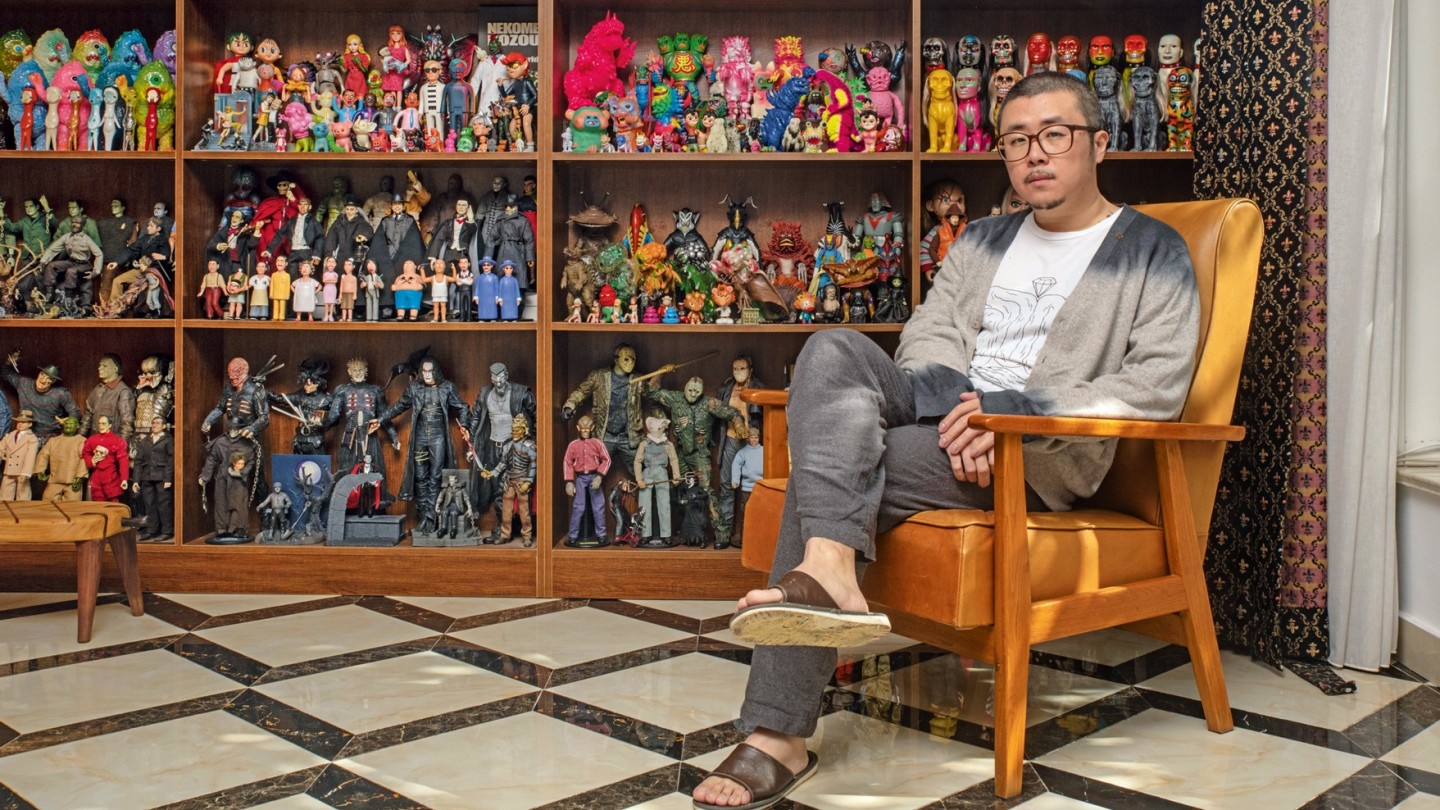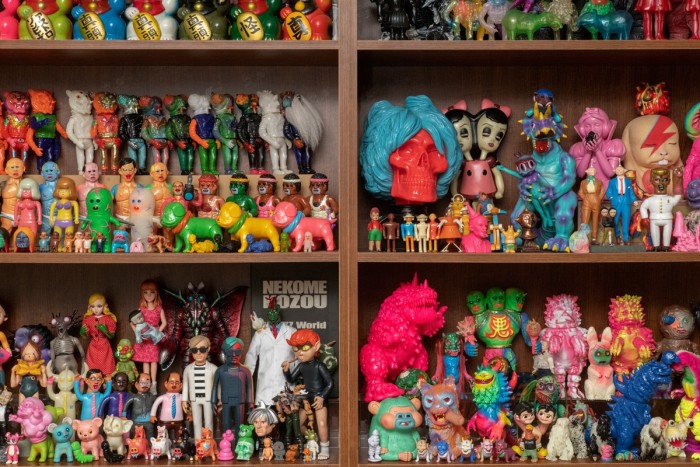Is this the most extraordinary toy collection in the world?

Roula Khalaf, Editor of the FT, selects her favourite stories in this weekly newsletter.
“Every toy geek has display cabinets arranged according to his own foolishness. Most of my collection is arranged by designer in one dedicated room at home. I haven’t counted the toys, but it’s certainly in the thousands, and the majority are sofubi – soft vinyl toys. Some that won’t fit in the cabinets, or those that I particularly cherish, are placed in eye-catching locations around the house, such as a bright-pink Giant Mockbat – an 80cm-tall bat sofubi with stumpy wings and a long tongue, designed by San Diego-based artist Paulkaiju, also known as Paul Copeland.
I’m not sure if it was China’s relative deprivation when I was growing up in the ’80s that made me a collector, but it’s true that I didn’t have a lot of toys as a kid. I played with the same sorts of things as other kids, mostly GI Joes – called Special Forces in Mandarin – and Transformers. The first toy I remember being given was a Transformer, which my dad bought me. Actually, it was a knock-off, not based on any character in the cartoons, but could change into seven different forms.
I developed a bad habit when I was young: every night before going to sleep or going out, I’d choose a special toy to take with me. The more I liked a toy, the more it would get chosen, but then I would hesitate, not taking the one I liked most in case it got lost or damaged and the colour wore away. Even when it was just a gashapon, those Japanese capsule toys bought from vending machines, I wouldn’t think about throwing them away. And I still hold on to toys I don’t like any more. They’re packed up in boxes but, so far, I haven’t sold even one item in my collection. I have tried to swap with other collectors in the past, when I really wanted something in someone else’s hands, but we never agreed to the particulars of the deal.
I have toys by KAWS – the artist name Brian Donnelly took on when he was working as an animator for Disney – and many others, but the most expensive items in my collection are those by contemporary artists Takashi Murakami and Yoshitomo Nara. I’ve either purchased their toys at online auctions or found people to buy them for me. I have a Nara Mori Girl, whose hair resembles a pine tree, which you can see at almost every Sotheby’s and Christie’s auction in Hong Kong. I still just think of them as toys, though, so I don’t pay attention to the market and I’m not sure what they’re worth. [A hand-painted wooden Mori Girl, one of an edition of 200, sold at Sotheby’s for about £47,020 earlier this year.] I also have figurines of girls who transform into fighter jets, derived from Murakami’s three-part sculptural installation Second Mission Project ko2 (2000) and produced by the toy company Kaiyodo.

My favourite store for buying sofubi is Mandarake in Tokyo. I sometimes acquire toys through dealers, who I prefer not to name, but it’s not the only way I get them. When everyone knows you collect a lot, plenty of people ask if you’re interested in their stuff. There are also groups of toy enthusiasts on WeChat, where both chatting and trading take place, rather than on specialist websites. At the same time, Chinese toy fans all pay close attention to what’s happening on Yahoo! Japan and Japanese Amazon, where a silver NagNagNag “longneck”, a limited edition of 10, is currently selling for about £3,335.
If my house were burning down the one toy I would grab would be a NagNagNag – beautiful but grotesque sofubi created by Shigeru Arai and a team of Japanese designers. They launch new items three times a year, and I’d say there are only about five items per drop. Many are one-off pieces you can only buy after winning a kind of lottery on the NagNagNag website. I have several Four-Eyed Boryoku Genjin, amphibious-looking monsters designed by Arai, which I love. Because the designs are unique, the makers ask buyers not to share pictures of them. There’s even an unwritten rule within toy groups only to share black-and-white photos because, even if the form is similar to something else, the colouring is unique. This keeps them from being copied.
I think that NagNagNag designs are more like spiritual talismans than toys. I can almost feel them breathing. They’re the Giacometti of toys. Because they’re so rare, they can be worth thousands of dollars each. I wouldn’t dare say I’m the biggest collector of NagNagNag in China, but I have a lot – around 30. Still, it’s never enough. What compels me to keep collecting is looking around the house and seeing space that’s not yet filled. It makes me uncomfortable. You could call me a hoarder. I’m obsessive.
My aesthetic tastes have matured over the years but I’m still afraid people will think my hobby is juvenile. So while I’m happy to share my collection with others it’s rare that I actually talk about it with friends. The people who visit are mostly friends from art circles, who tend to find the toys ugly. The more I try to explain the unique aspects of each toy, the more childish it seems. But NagNagNag toys are something I’ll love forever, obtaining as many as I can, whatever the price.
My collection provides me with aesthetic stimulation that I don’t always get in my daily life. Sometimes my sofubi toys appear in my paintings – still-lifes like the ones I’m showing at Perrotin in New York. When my concepts are most intense, I like to make works that look softer, subtler. I also collect art, mostly by young Chinese artists, such as Ran Huang, Chen Wenling and Lu Pingyuan, as well as pieces by foreign artists, including Austin Lee, Ambera Wellmann and Maurizio Cattelan, which I collect purely because I like them. There are some artists whose visual languages I don’t dare go near in my own work, but which I really admire. Of the earlier generation, I really, really like Japanese artist Izumi Kato’s work; it has an indefatigable vitality that always expresses something new and surprising. I think the most precious piece of art I own is a Kato: a small work on paper depicting his familiar boy figure writing my two names. He gave it to me when I got married. Every time I see it I feel deeply moved.
There are definite relationships between my art collection and my toy collection, but not everything overlaps. For instance, I have some peculiar interests when it comes to toys that don’t really appeal when you see them in contemporary artworks. I have firm beliefs about what contemporary art should be. I can accept art that is done badly as long as it is true. The art that moves me all has this quality of truth. Toys, on the other hand, are one of life’s simple pleasures.”
Comments